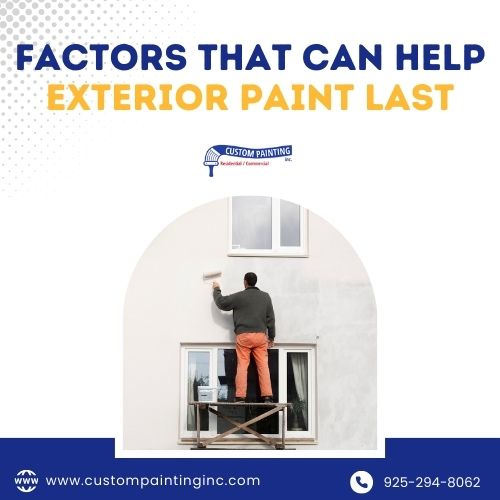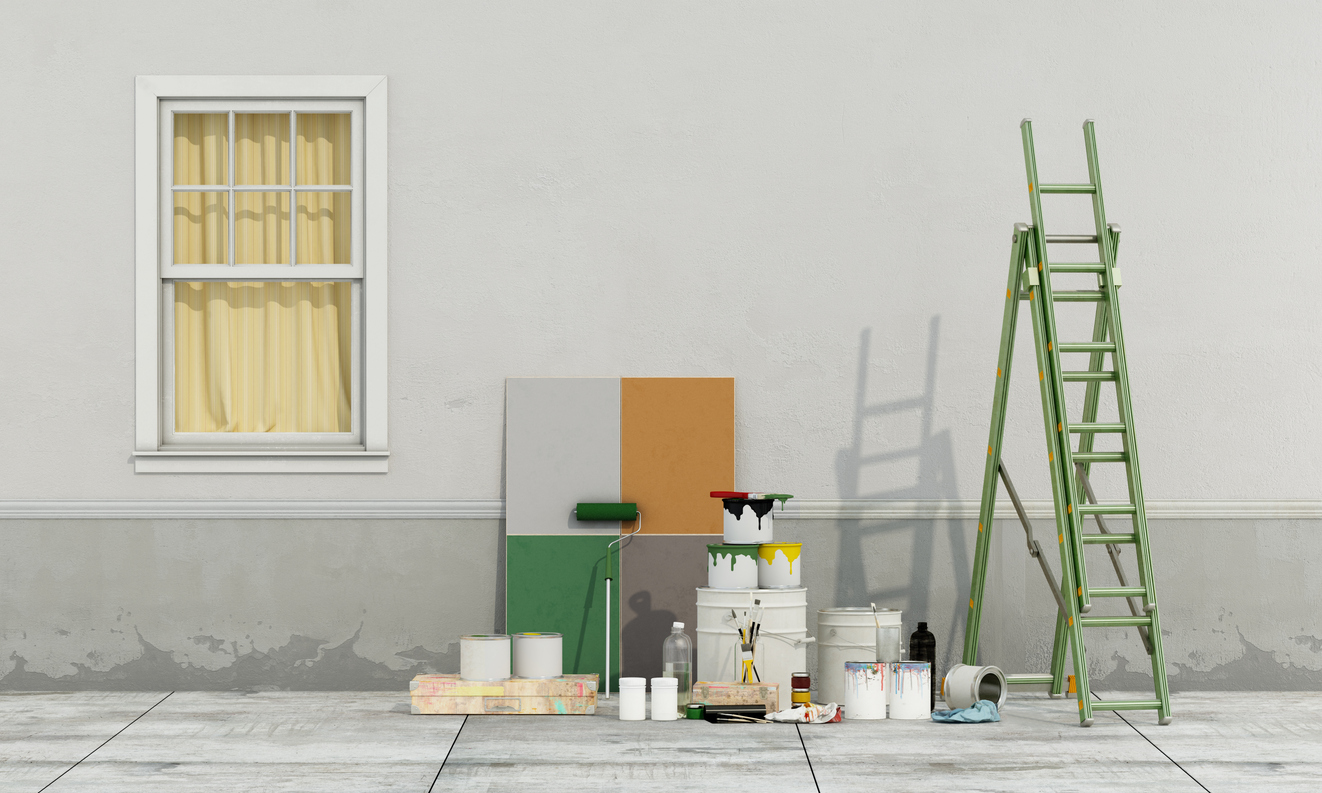Not all paint jobs last long. A quality paint exterior job can last around ten years, perhaps longer, with regular and proper maintenance. The difference between a paint job that fades and flakes within a few years and one that stays vibrant and durable for a decade can come down to a few key decisions.
So, how do professional painters in the Bay Area make exterior paint last longer? Let’s explore the factors that affect the longevity of an exterior paint job and provide practical tips to ensure it looks great for years to come.
Choice of Paint
There’s an oft-repeated saying: “You get what you pay for.” This is true when it comes to paints. The quality of your paint can affect how well it holds up. Cheaper paints may save you money at first, but they’re more prone to fading, peeling, and cracking more quickly than premium paints. Premium paints, on the other hand, offer better coverage, durability, color and finish retention, and resistance against weather and moisture.
Here’s what you need to consider to make the best choice:
High-Quality Ingredients
Opt for paint that contains high-quality resins, pigments, and additives. These components help the paint adhere better, resist fading, and withstand weather conditions. Higher quality paints might come with a higher price tag, but they can save you money in the long run by reducing the frequency of repainting.
Built-in Primers and UV Protectors
Some exterior paints are formulated with built-in primers, which can enhance its adherence and durability. Also, look for paints that include UV protectors. These can help keep the colors vibrant and prevent paint from degrading due to sun exposure, especially in sunny climates.
Water-Based vs. Oil-Based
Water-based or latex paints are popular due to their ease of use and quick drying times. They’re less odorous, easier to clean up (only water is needed), and generally more environmentally friendly. Latex paints are also flexible, allowing them to expand and contract with the siding, reducing the risk of cracking.
Oil-based paints are typically used for exteriors because they are durable and can create a smooth, uniform finish. They are good at sealing out moisture, making it ideal for harsh weather conditions. However, they take longer to dry and require solvents for cleanup.
Finish Options
The paint finish you choose affects its longevity and appearance. Here are the common finishes and their best uses:
- Gloss and Semi-Gloss: These finishes are excellent for areas that face high exposure to moisture and wear, like window trims and doors. They are easier to clean but tend to highlight imperfections.
- Satin: This finish is ideal for siding as it has a slight gloss, is easy to clean, and doesn’t highlight imperfections as much as higher gloss options.
- Matte or Flat: While these can offer a pleasing aesthetic and hide surface blemishes well, they are less resistant to staining and harder to clean.
Proper Surface Preparation
Proper surface preparation is arguably the most critical step to ensure the longevity of your paint job. Even if you use the highest quality paint, it won’t stick properly or last long if applied to a poorly prepared surface.
Professional paint contractors consider cleaning and preparation very essential to achieve the best results on painting your home’s exterior. These are the steps to preparing the surface before painting:
Cleaning the Surface
Before any paint touches the walls, the surface must be clean and free of dirt, mildew, and grime. You can clean by power washing or hand scrubbing. Power washing is effective for removing built-up dirt and debris. For more delicate areas, scrubbing it using a brush and a mixture of water and mild detergent can be very effective.
If there’s any mildew present, treat it with a solution of bleach and water (1 part bleach to 3 parts water) or a commercial mildew remover. Ensuring all mildew is gone is essential, as the paint will not adhere properly to a mildewed surface.
If you don’t clean the surface properly, the paint applied will likely peel off prematurely. Also, the dirt and oils trapped under the paint can degrade the paint from underneath, causing it to crack or bubble as it loses its ability to adhere properly.
Sanding and Smoothing
Once the surface is clean, you may need to sand it to remove any peeling paint or to smooth out rough areas. Use sandpaper or a sanding block to smooth out rough spots, feathering out edges where old paint has peeled off. Then, fill in any cracks or gaps with a high-quality exterior caulk. This not only helps create a smooth surface but also prevents water from seeping under the new paint, which can cause it to peel prematurely.
Priming
While you may not have to use primer, it is used in certain conditions, such as previously painted surfaces. Primer provides an even surface for the topcoat to cling. It also protects against moisture, stains, or vapors from the interior walls or gaps. A good-quality primer will also help when you paint over a porous, darker, or porous surface. For best results, use two coats of primer before painting the topcoat.
Proper Tools
Even the tools you use for painting can make or break your paint job. High-quality brushes are crucial for detailed work and small areas. These kinds of brushes offer excellent control and allow the paint to penetrate the surface better, which is especially important for textured surfaces like wood grain.
For covering large and flat areas, rollers are ideal. They provide a more uniform application than brushes and can save time. Be sure to choose the roller nap thickness based on the texture of your surface—rougher surfaces require thicker naps.
On the other hand, paint sprayers offer the fastest application and can achieve a very smooth finish. They are useful for painting large or intricate surfaces where brushes and rollers might not be efficient. However, they require more skill and preparation to avoid overspray and uneven coverage. Professional painting contractors often have these tools at their disposal.
Weather Conditions
The weather plays a huge role in how well paint applies and adheres. Common sense will tell you not to start a paint job when it’s raining or snowing.
Also, keep in mind that most paints require a certain temperature range (typically between 50°F and 90°F) for optimal application and curing. Paint can behave unpredictably outside this range.
If it’s very humid outside, paint will not dry as fast as it should, and it also affects paint consistency. It’s best to paint on days with moderate to low humidity to ensure that the paint cures properly.
Also, direct sunlight can cause the paint to dry too quickly, which can lead to brush marks and uneven color. It’s often best to paint in shaded areas as the sun moves. Keep the surface you are painting out of direct sunlight as much as possible.
Experience of Painting Professionals
While taking on an exterior painting project yourself can be rewarding; there are times when hiring a professional painting service is the best choice. Professional painters can offer a level of precision and efficiency that might be hard to achieve on your own. Here’s why and when you might consider enlisting the experts:
Expertise and Experience
Professional painters bring a wealth of experience and expertise to your project. They know exactly how to prepare surfaces, choose the right materials, and apply paint for optimal durability and finish.
Professionals are also adept at identifying and solving complex issues like moisture damage, mold growth, and uneven surfaces that might not be apparent to the average homeowner.
Time and Convenience
Professional painters can complete the job faster due to their skills and access to a team and professional equipment. This is particularly advantageous if you have a large home or are pressed for time.
Hiring professionals means you don’t have to worry about purchasing the right supplies, setting up scaffolding, or dealing with cleanup. They handle all aspects of the job, from start to finish.
Safety
Exterior painting often requires working on ladders or scaffolding, which can be risky for the inexperienced. Professionals are trained to handle such situations safely.
Also, some surface preparations and painting techniques involve the use of potent chemicals that require careful handling and disposal. Professionals are equipped to manage these safely and responsibly.
Long-Term Cost Effectiveness
A professional job often lasts longer due to better surface preparation and application techniques. This can make it more cost-effective in the long run, as the paint maintenance and redo intervals will be extended.
Plus, many professional painters offer a warranty on their work. This can give you peace of mind that any issues related to the application will be resolved without additional costs.
Conclusion
A successful exterior painting project is much more than just picking the right color and slapping on a coat of paint. It’s a thoughtful process that involves choosing high-quality materials, preparing surfaces meticulously, applying paint with the best techniques, and maintaining the finish to ensure longevity.
Ready to give your home a fresh, durable new look with long-lasting exterior paint? Or perhaps you’re looking for expert advice to tackle specific challenges in your upcoming painting project in the Bay Area? Call Custom Painting Inc. at (925) 294-8062 or complete our online estimate request form. We always provide estimates free of charge.



